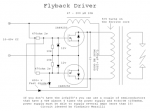- Joined
- Aug 14, 2013
- Messages
- 2,640
- Points
- 63
Because I was planning to make the transformers and did not want to wrap 20000 coils of wire
The real problem is the fast HV diodes.
They are difficult to find and expensive.
That is another reason why we are using TV
flyback transformers. They are already
wound for us and have all the diodes and
everything we need inside.
Last edited:







